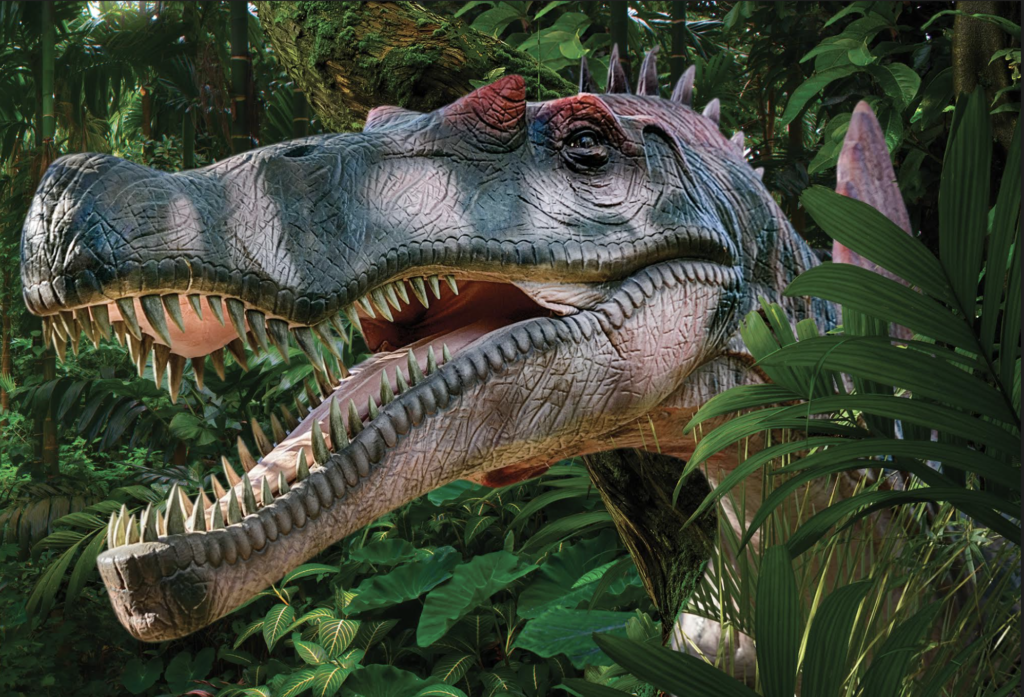Meet the Roaracious Crew

Reid Park Zoo is bringing dinosaurs to Tucson this Spring with Dinosaur Discovery! Without further ado, allow us to introduce the prehistoric guests soon to be seen at your Zoo:
Tyrannosaurus Rex –(tie-RAN-oh-SAW-rus). One of the most recognized and widely-feared dinosaurs, its mouth was lined with 60, seven-inch teeth, and some paleontologists believe it may have run as fast as 60 miles per hour! It was discovered in 1902 in Montana.
Triceratops – (try-SAIR-uh-tops). One of the last dinosaurs to walk the earth, it was known for its large skull, neck frill, and three menacing horns used to defend itself from predators or to sometimes battle other Triceratops. Despite its fearsome presence, this dinosaur was a plant-eater, using its rows and rows of teeth and sharp beak to slice and crush all sorts of vegetation. It was discovered in 1887 in Colorado and at the time mistaken for a gigantic species of extinct bison.
Hadrosaur – (Had-roe-SAWR) – A duck-billed dinosaur with as many as 1000 teeth, Hadrosaurus stood on its hind legs when running, but used its front feet to support its head while grazing. This peaceful plant-eater is a famous dinosaur because it was the most complete dinosaur skeleton anywhere in the world when it was discovered and documented in 1858 in the New Jersey area.
Minmi – (Min-mee) – A smaller dinosaur found in Australia and discovered in 1964, it was covered with body armor, much like armadillos today.
Iguanadon – (Ee-GUAN-A-DON) – Thought to travel in herds, it had distinctive features including large thumb spies and an opposable digit like a human thumb that it used to grasp branches and forage for food. It was discovered in Sussex, England in 1822.
Spinosaurus – (SPINE-OH-SAW-RUS) – The world’s largest carnivorous dinosaur (larger than T-rex and Gigantosaurus) discovered in Egypt in 1912, it stalked fish and small prey at the water’s edge and was the first known dinosaur able to swim.
Neovenator – (NEE-oh-VEN-ah-tor) – One of the top predators of the Cretaceous period discovered in 1978 in what today would be England’s Isle of Wight, it was a very large dinosaur with a slim build. Each hand and foot had three very sharp claws and its teeth were blade-like for cutting flesh. Unearthed fossils show injuries indicating that these animals had rough and tumble lives.
Protoceratops – (pro-toe-SAIR-uh-tops) – this herbivorous dinosaur had a parrot-like beak and a bony frill at its neck used for display to other Protoceratops. It was discovered in the 1920s in the Gobi desert in Inner Mongolia.
Herrerasaurus – (her-RARE-uh-SAWR-us) – A predator and one of the earliest dinosaurs that walked on two limbs, this dinosaur was discovered in 1991 in Argentina. Bite marks on the skulls of these animals indicate they often battled one another.
Leaellynasara – (LEE-el-IN-UH-sawr-UH) – A small, bipedal dinosaur from Australia, it had a remarkably long tail which contained over 70 vertebrae and comprised as much as 75% of its total body length. Unlike reptiles today, its top and bottom teeth touched when chewing. This dinosaur was discovered in 1989 in Dinosaur Cove, Australia.
